Buyer's Guide - Entry Level, January 2005
by Jarred Walton on January 9, 2005 12:05 AM EST- Posted in
- Guides
Small Form Factor Considerations
One of the options that we didn't mention earlier was the possibility of a Small Form Factor (SFF) case. While normally that would add quite a bit to the price, there are a few options that offer very competitive prices and some people will prefer them to purchasing a separate case, motherboard, and/or power supply. Considering that the systems we've put together so far cost roughly $150 for the motherboard and case/PSU, that's our target price for a SFF case. We're willing to go as high as $200, however, as the reduced size may be desirable for a lot of people. There are a decent number of cases that fit that requirement, but we will limit ourselves to the ASUS, BIOSTAR, EPoX, Shuttle, and Soltek offerings for now. (We're still working on the full SFF roundup, in case you were wondering.) Due to pricing concerns, most of our selections will be from the socket 478 and socket A platforms. 754 and 775 are available, but they tend to cost too much for a budget system.  |
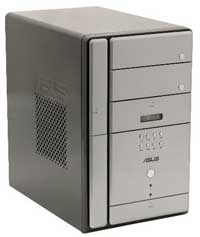 |
| Click images to enlarge. | |
Socket 478 SFF Alternative: ASUS Terminator T2-P or T2-P Deluxe
Price: $137 or $162/$220 shipped
Providing one of the best values for a SFF system, the ASUS T2 line includes a ton of features. Integrated graphics come standard via the 865G chipset, or if you want to look at the T2-R, you could get the ATI 9100IGP graphics - as we mentioned in the motherboard section, the ATI 9100IGP provides better graphics support, but worse overall CPU performance. Sound and networking are standard fare, along with two DIMM slots. The Deluxe model adds in 802.11B WLAN, a gigabit Ethernet (GbE) connection, firewire, a flash card reader, and a radio tuner, along with an enhanced front panel with controls for the radio and CD functions. Both models include a floppy drive.
The case looks good and runs reasonably quiet, but there are a few drawbacks. First, the hinged front covers look nice, but they feel very flimsy; they're not spring loaded, and they're made of cheap plastic. If you don't handle your computer with care, it would be relatively easy to break off some of the plastic "doors". Another problem is that the Deluxe model is available in two versions, so you'll have to make sure that you get the right one. The cheaper version does not include the wireless networking, firewire, GbE, or a CD drive while the "commercial" version adds these extras. The power supply is only rated at 200W, so running a high-end graphics card like a 6800GT or X800 Pro could prove troublesome, but we can attest that the 9800 Pro/XT work without problems. Finally, the case is not a truly small SFF design - it's really about half the size of a standard mini-tower and 50% larger than most other SFF cases. Still, it's not a bad value overall, regardless of which model you choose.
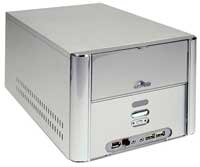 |
 |
| Click images to enlarge. | |
Socket A SFF Alternative: BioStar iDEQ 210VB or 200N
Price: $172 or $207 shipped
For socket A from BioStar, we have two options that meat our criteria. The cheaper option is the 210VB, which uses the VIA KM400A chipset and includes the UniChrome integrated graphics. It also includes firewire, USB, SATA, audio, and 10/100 Ethernet. The more expensive 200N is the preferred version, not only because it uses the superior Nforce2 chipset with MCP-T, but also because it includes two VGA ports powered by a GeForce 4MX core and we prefer the silver aluminum case to the black one. Otherwise, they are very similar in design and features. Again, high-powered graphics cards might push the capabilities of the included 200W PSU, but then a high-powered graphics card would be overkill for an aging Athlon XP/Sempron system. Note that this motherboard supports a maximum bus speed of 333 MHz, so the 400 MHz bus Athlon XP 3000+ and 3200+ are not an option. Given their price, however, we don't think that many people would really consider them anyway.
Socket A SFF Alternative: EPoX Mini Me EP-EX5300NR
Price: $221 shipped
Socket 478 SFF Alternative: EPoX Mini Me EX5-300S
Price: $192shipped
These two cases look very similar internally and externally, but there are a few major differences. First is the CPU socket type, of course, which dictates many of the features. The socket A model also includes a remote control and 250W PSU (instead of a 200W), but it lacks support for SATA - that's important, considering our hard drive recommendations; get a Seagate or Samsung IDE drive instead if you choose the EX5300NR system. Beyond that, features are similar to what other cases offer: firewire, audio, LAN, USB and integrated graphics - the Nforce2 IGP's GF4MX for the AMD system and the 865G's Extreme Graphics 2 on the Intel platform. Both models do not support a floppy drive, although they also come with a flash card reader in the 3.5" bay. On the bottom of the front face is a moderately large display that can be configured to show system parameters; some may like it, and others may find it distracting, as it does tend to be a little bright at face level. Similar to the BioStar cases, only 266 and 333 FSB Athlon XP/Sempron are supported on the socket A model.
Finally, a word of caution: this is a case that may be too small for its own good, as fitting in a moderate size graphics card can bump into the hard drive, causing it to warp the graphics card slightly. We're not particularly thrilled by that prospect, so we would recommend that users who intend to add a decent graphics card to their system look elsewhere. Given the price, features, and diminutive size - remember that in the SFF world, smaller is generally more expensive - it's a decent option, provided that you keep the above comments in mind.
Socket 754 SFF Alternative: Shuttle XPC SK83G
Price: $207 shipped
As our sole representative of the socket 754 platform, we have the Shuttle SK83G. Shuttle also has a few other moderately-priced offerings that some might find interesting, but they tend to cost more than some of the competitors and offer less in the way of features. For example, the SB65G2 is a decent model that lacks integrated graphics, so a separate graphics card would be required. The SN45GV2 is similar in that it uses the Nforce2 Ultra chipset and requires discrete graphics. On the low end, we have the SB51G that includes integrated graphics, but uses the 865GE chipset instead of the slightly more powerful 865G. None of them are terrible choices, but they also don't have much to set them apart in the budget sector.
Returning to the SK83G, let's look at the features. It is reasonably priced and includes a 240W PSU, integrated UniChrome Pro graphics courtesy of the VIA K8M800 chipset, plus all of the other usual suspects: firewire, USB, SATA (plus RAID), audio and networking. An S-Video connection is supported in addition to the VGA connector, which makes this an interesting option for a Home Theater PC if you're interested. Something that other cases neglect is the inclusion of a cover for the 3.5" external bay, should you decide to forego the floppy drive or use that bay for a second hard drive.
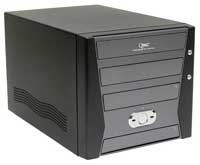 |
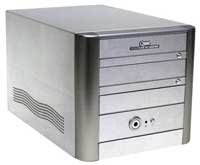 |
| Click images to enlarge. | |
Socket A SFF Alternative: Soltek QBiC EQ3704GD or EQ3705A
Price: $177 or $192 shipped
Wrapping things up with our SFF suggestions, we come to Soltek and their QBiC line. There are several systems that fall into the $200 and below range, but we aren't going to bother with the VIA C3 options, so we're left with the versions based on the KM400A VIA chipset and the NVIDIA Nforce2 IGP. The 3704 is available in several different color schemes, of which we selected the gray/black model. It's a little cheaper than the 3705, but you also lose some performance on the CPU and graphics fronts. In other areas, however, you gain some features: the 3704 includes GbE as well as SATA/RAID, while the 3705 lacks these features. As with the EPoX system, if you are considering the 3705, make sure that you get an IDE drive instead of an SATA drive. It's a personal preference, but we also prefer the look of the aluminum 3705 case. Otherwise, features are the same as the other options: firewire, USB, audio, and network. The Soltek models also include a larger 250W PSU, and you can even fit two optical drives in each case. Using the bottom 5.25" drive bay for a second optical drive will prevent the use most PCI cards, however.


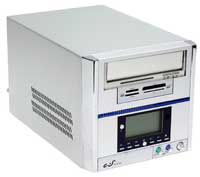
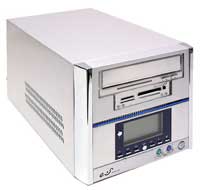
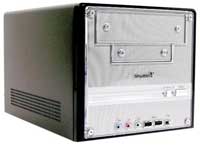








31 Comments
View All Comments
JarredWalton - Friday, January 21, 2005 - link
Next Guide is due out "soon" - like this weekend probably.As for PATA vs. SATA, the performance difference is negligible. The cables are a different story. PATA (also called IDE/EIDE) uses 40 pin connectors and 80 pin cables. SATA gets by with a cable that's about 1/4 as large, and the connector is only about 1 cm wide instead of 5 cm or so. Rounded IDE cables help, but the IDE connector is still rather a pain in the butt.
Also, SATA is point-to-point, which means there are no worries about master/slave settings. Each SATA device is on its own channel. The theoretical performance of SATA is higher than PATA, but in practice all current hard drives are limited by the hard drive's sustained transfer rate.
Fauno - Thursday, January 20, 2005 - link
Dumb question: what´s the difference for SATA and PATA?Tkx for all.
Fauno - Thursday, January 20, 2005 - link
Mr. Jarred, thank you for the great newsletter!I would like to see an improved, i mean, something
better than the Budget and Performance scenarios.
How long may i have to wait for your next guide?
I´m anxious because i´m in hurry to make a brand new computer.
Thank you vey much.
micronot - Monday, January 17, 2005 - link
Show me the Benhchmarks ---I have no complaints about the selections, but it would have been nice to also see how these systems compare on a few benchmarks. This would help show a price to performance ratio.
erinlegault - Wednesday, January 12, 2005 - link
How do think nForce motherboards have instability at default settings?I know VIA has been very reliable since their Apollo Pro 133 chipset, I have owned several. But, to say Nvidia nForce chipsets are unstable is unfounded. The various flavors of nForce 2, 3 and now 4 are the probably the best chipsets ever made.
I have no opinion about the initial nForce chipset, I personally never give first timers a chance. This is probably the chipset you call unstable, but what company does not produce a first generation product that isn't perfect.
bob661 - Tuesday, January 11, 2005 - link
I don't recommend Nforce boards to non-enthusiasts because of instability or just plain quirkiness (sp?). I figure a geek wouldn't mind troubleshooting and tinkering but I don't assume that for newbies or general users. VIA has always treated me kindly and I don't have people coming back to me after I build them a computer complaining about quirks. I remember when VIA was the quirky, problem-ridden chipset but I haven't seen that for at least 5 years. We use computers with that chipset at work as CAD workstations (29 machines) and there's no instability.Live - Tuesday, January 11, 2005 - link
If the 6600 is an option in PCIe why not as AGP it is available in both?woodchuk - Tuesday, January 11, 2005 - link
Have to agree on the VIA and SIS chipsets, not only because they tend to lose sound drivers and such occasionally, but the nVidia solutions seem bulletproof.Also, the Semprons I've built recently are very disappointing in anything that likes a lot of cache, either Tbird or Barton equivelents are faster.
justly - Tuesday, January 11, 2005 - link
Thanks again, although I really wasn't expecting a responce to my last post.I understand the reluctance tward integrated video, but to be fair there are two reasons for building a budget system one is obviously because you cant afford the alternitive, and the other is because you know you dont need the alternitive. If someone is simply trying to make a performance system fit a tight budget then I would expect them to have problems simply because that is not the correct way to make a performance system. Is this the type of person that you are making a budget guide for? if so then I guess I misunderstood the purpose of the budget guide.
I'm NOT intentionally trying to argue with you, it just irritates me that the impression I (and I think others may also) get from the article is that Nforce is not just the chipset of choice but that it seems to be the only chipset that is acceptable, and now I see you say "a less expensive chipset isn't necessarily inferior". That was the point I was trying to make.
A lot of what you say makes sense, but a few things don't (at least to me), one being that you assume cheaper capacitors, resistors, fabrication facilities, etc (along with cheaper chipsets and less features) are used to make a budget board, but unless the Nvidia chipset is cheaper or the board has less features then the only way a Nvidia motherboard can compete in price is to use as cheep or cheeper parts or fabrication facilities yet you still claim it is more stable/compatible, how can this be? ok maybe it is the BIOS, I guess I just have a hard time believing that every non-Nvidia moterboards out there has problems with their BIOS.
My experiances are a little different than yours. I have had very little or no problems with SiS or ALi drivers in the past (VIA is a different story). When the K6-2/III was popular I had both ALi and VIA based motherboards and I would say without a doubt that I liked the ALi better. On the Athlon platform I can also say without a doubt that I liked the SiS better than the VIA. While I personally haven't owned a Nvidia chipset I do know of more than one person that had problems with them (and they where not budget builds either, in fact they where top of the line in most cases).
Having a bias is normal everyone has them, I just think with a following as large as what Anandtech has you should try to hide that bias a little better. Maybe it is time you try a SiS or ALi/ULi chipset again, you might be pleasantly surprised. Then again maybe you know yoou need more than SiS or ULi can give you in that case continue on with your "self-perpetuating bias. :p" just kidding, have a nice day and thanks for the insight regarding your recommendation.
JarredWalton - Monday, January 10, 2005 - link
Let me go back to an earlier statement, just to make sure we're all on the same page. I said the following on page 2: "There are boards that use the VIA K8M800 chipset with its S3 UniChrome Pro graphics, and there are also boards that include the SiS Mirage graphics. Performance and reliability of either one are questionable in our opinion." Just to make this clear, the "questionable" aspect is specifically in regards to the integrated graphics - lowest common denominator graphics almost always cause me grief. Some will only support 24-bit color, which is not 100% compatible with all applications, forcing you to use 16-bit mode at times. Others simply perform very poorly even in 2D applications, and then there's the supported refresh rates which may end up being 60 Hz at any resolution above 1280x1024.Okay, now back to the topic at hand....
Memory compatibility issues can come from a variety of areas. For example, even with an Intel 865PE chipset, you're not going to see identical performance or compatibility across all motherboards. It probably has a lot to do with the BIOS, not to mention some other items like quality and location of capacitors, resistors, etc.
THG did a memory comparison maybe six months back where they tested about 10 to 15 different brands of RAM on 10 to 15 different motherboards. I don't recall the specifics, other than the ASUS K8V SE Deluxe was the most compatible motherboard (working with all the RAM types used) and that the Corsair RAM was the most compatible RAM.
As I'm not a BIOS programmer or motherboard manufacturer, I can't say for sure what causes the issues that some boards experience, but I can hazzard a guess. Let's assume you're trying to make a budget board that will sell for $25 less than other motherboards. The first step is usually to go with a cheaper chipset, i.e. SiS or ALi or VIA as opposed to Intel or NVIDIA. (I don't know how expensive NV chipsets are, but I know that Intel is regarded as the most expensive out there.) Now, a less expensive chipset isn't necessarily inferior, but I have a feeling a lot of motherboards that use cheaper chipsets also use cheaper capacitors, resistors, fabrication facilities, etc.
I would guess that this is why the ASUS A8V Deluxe and the Abit AV8 are still very good boards even with the VIA K8T800 Pro chipset. They also cost nearly as much as competing NVIDIA boards. As with all things, compromises are made to reach any price point. If most motherboards with a certain chipset sell for $85+ and a new board comes out that only costs $70, you can be almost sure that either features or quality were cut - possibly both. Long-term reliability of cheap motherboards has never been good for me, although I'm sure others have had okay experiences.
Beyond that, I don't have any real concerns with the VIA A64 motherboards. SiS and ALi/ULi are a different matter, although I freely admit that I have avoided using motherboards with those chipsets for years. Finding comprehensive chipset drivers for NVIDIA, Intel, and VIA motherboards is generally a simple matter; not so with SiS and ALi (in my experience). Drivers always end up mattering, and the easier it is to get all the drivers installed, the better.
In the end, it's a Catch-22 situation: I don't trust SiS and ALi/ULi based motherboards as much as NVIDIA and Intel based motherboards due to some bad experiences. The only thing that would really convince me that they no longer have problems would be extended use of such a motherboard over a two year period. However, when I look at the prices and it's only $10 more for a board that I already trust, why take a chance?
I'm only one person, with limited access to hardware (even if I have more access than most people, I can't just get anything I want). No one has perfect knowledge of how specific boards will work over a 4 year period, so we end up guessing based off of previous knowledge. My previous knowledge says that SiS and ALi boards are more likely to have issues over an extended period of time, but what I really know is that *previous* SiS and ALi boards had a lot of problems. Yup, it's a self-perpetuating bias. :p